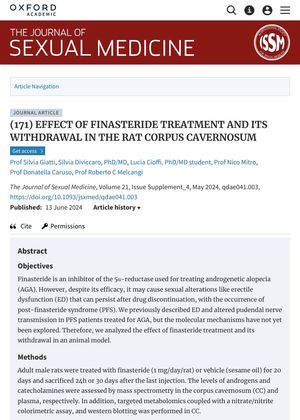Effect of Finasteride Treatment and Its Withdrawal in the Rat Corpus Cavernosum
May 2024
in “
The journal of sexual medicine
”

TLDR Finasteride treatment may cause erectile dysfunction, but stopping it reverses these effects.
The study investigated the effects of finasteride treatment and its withdrawal on erectile function in male rats. Finasteride treatment led to molecular changes indicative of erectile dysfunction, including increased plasma norepinephrine, decreased epinephrine, reduced 5α-reductase type II protein levels in the corpus cavernosum, and decreased activity of nitric oxide synthase and ornithine transcarbamylase. These changes were not observed after withdrawal of the drug. The findings suggest that finasteride treatment, but not its withdrawal, induces molecular alterations that may contribute to erectile dysfunction. Future research will explore the impact of finasteride withdrawal on neural circuits controlling male sexual behavior.

